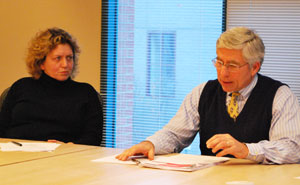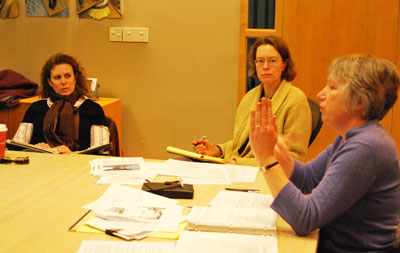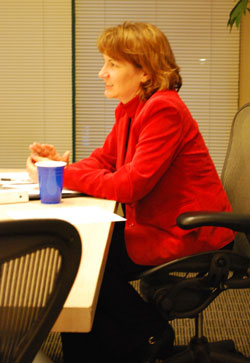Educating the Public about Public Art

Katherine Talcott, the new part-time administrator for the Ann Arbor Public Art Commission, and commissioner Jim Curtis at Tuesday's meeting.
Public Art Commission (Feb. 10, 2009): With two new commissioners and a newly-hired administrator on board, the Ann Arbor Public Art Commission spent a good portion of Tuesday night’s monthly meeting discussing the need to communicate better with the public and to educate them about the value of public art in Ann Arbor. That issue was in response to a Feb. 3 Ann Arbor News article – and the comments posted after it by eight readers – about the commission’s decision to enlist German artist Herbert Dreiseitl to design a waterscape installation at the police-court building, which will begin construction in April. The comments from News readers weren’t exactly supportive of that choice, or of the $72,000 that Dreiseitl is requesting for his initial design work, which represents about 10% of the potential $700,000 total price tag.
Margaret Parker, AAPAC’s chair, said she wanted to prepare a packet for city council’s Feb. 17 meeting, where council is expected to vote on the contract with Dreiseitl.
Commissioner Marsha Chamberlin said it seemed like they were moving from Point A to Point D, spending $72,000 without having the design concepts in hand. Commissioner Elaine Sims said that’s the way things go when you work with a high-powered artist like Dreiseitl. “Yes,” said Chamberlin, “but we didn’t know that going in.”
Assuming council approves the contract, the commission will wait until Dreiseitl delivers his design. At that point, a task force – Parker and commissioner Jan Onder – will recommend whether to accept the design, and AAPAC will vote on that recommendation. The commission has set aside up to $700,000 for the project, out of the city’s percent for public art program. That program designates 1% of the cost of any public building project for art, with a cap of $250,000 per project. The Dreiseitl piece, which has been discussed for several months at AAPAC meetings, would be the group’s first major project using the 1%-for-public-art funds.
Later in the meeting the topic resurfaced when commissioner Cathy Gendron gave a presentation about the publicity committee’s work. “I think we need to do a better job of explaining how a percent for public art works,” she said. One of the criticisms from readers of the Ann Arbor News article focused on why money was being spent on art during difficult economic times. “We need to answer those questions.”
Sims said there were two issues: 1) the city has said that art is as important as bricks, and 2) funding for public art doesn’t take away funding for buildings. Commissioner Cheryl Zuellig added that it might be helpful to use a specific project as an example, putting the art funding in context. There are line items for sidewalks, lights, signs – the percent for public art is simply another line item in the project’s budget.
Commissioner Jim Curtis said it was also important to note that the commission encouraged private donations of money and art – they weren’t just passive in receiving funds from the city government.
These are good ideas, Parker said, but “we’re way behind the 8-ball on educating the public. Now we have our first big project, and the public isn’t with us.”
Chamberlin then suggested setting up a blog with a Q&A addressing some of these issues, such as why the Dreiseitl project is important, and how the percent for public art program works. Jean Borger, the commission’s administrative coordinator, suggested posting the group’s meeting minutes as well.
Community Projects: Updates
Commissioner Jim Curtis gave status reports on several proposed projects – in part his report was intended to bring new commissioners Connie Rizzolo Brown and Cheryl Zuellig up to speed. Projects included:
- SoundFall, a proposed computer-programmed LED light display for the Maynard Street parking structure that can respond to voices and other sounds in the environment. The technology still isn’t there to pull this off, Curtis said, and organizers have a lot of work to do.
- Village Green, a proposed condo building and parking structure at First & Washington. It’s not clear whether this will be built, Curtis said. If it is, the commission would receive funds from the Downtown Development Authority through the 1% for public art program.
- Ann Arbor Skatepark, which is raising money for a site at Veterans Park. It’s not a publicly funded project, but skatepark organizers would like a public art component. They’ll be making a presentation to the committee next month, Curtis said.
- Other proposed projects in various stages include a mosaic work that a private donor would like to fund; a joint project by the youth group Project S.N.A.P. (Share, Nurture, Act, Preserve), the Ecology Center and the city’s solid waste management department, which Curtis said he had no details on; and a query from Magellan Properties, owners of the building at the southwest corner of Washington and South Fifth, who would like to do some kind of mural on the building’s exterior wall.
That last project raised a number of questions, Curtis said: What defines public space? How much control does the city have, via the art commission, over art that goes on private buildings? Cheryl Zuellig wondered whether the city could develop a public mural easement, which would set certain restrictions on that kind of project. Margaret Parker said that Mary Thiefels and Ellie Serras, who are both on the community projects committee, would do some research about how other cities approach this issue, then report back to the commission.

From left: Connie Rizzolo Brown, a new commissioner, administrative coordinator Jean Borger and commission chair Margaret Parker at Tuesday's Ann Arbor Public Art Commission meeting.
Prioritizing Sites, Projects
Commissioner Cathy Gendron leads a committee that’s tasked with identifying and prioritizing potential projects, possible sites where public art should be located, and potential funding sources. She reported that the committee had a brainstorming session to identify “gateways” to the city: Veterans Park; North Main as it comes downs from US-23; Washtenaw as it merges with East Stadium; State and Eisenhower; and the Lowertown/Broadway area, among others. They hope the city can provide a database of parcels that might be suitable for public art, Gendron said. The group also wants to address the issue of coordinating efforts with private property owners.
Parker asked Gendron to report to the full commission each month a list of priorities for each category – site locations, projects and funding. This led to some discussion among commissioners about how to do that, and whether setting priorities would limit their ability to be flexible in taking on projects as the opportunity arose. Parker argued that “sooner or later – and it’s going to be sooner – we need to get specific.”
Cheryl Zuellig suggested coming up with very clear criteria for setting priorities, such has whether the site or project has maximum impact. Asked by Parker if she’d draft a set of criteria, Zuellig said she would. Parker said the community projects committee, led by Curtis, will take over once projects have been vetted by the other committee.
Separately, Parker said that the commission needed to write a letter to Ray Detter, who leads the Downtown Ann Arbor Historical Street Exhibit program, about how that group and the commission will work together and coordinate their projects. Jim Curtis reported that he’d talked to Detter and that the historic program hopes to install bronze artifacts throughout the city to mark historic structures – for example, putting a full-sized bronze corset in front of a former corset factory on Main Street, and a near life-sized, seated banjo player on North Main, at the site of the former Hill’s Opera House.
Preservation Issues
Margaret Parker said the ceramic reliefs on the Fourth & Washington parking structure are showing more signs of cracks. The pieces had been commissioned by Barbara Bergman, a county commissioner, in memory of her husband, Reuben Bergman.
Marsha Chamberlin said she didn’t want to spend more money on the ceramics because they were too fragile for that site, which is exposed to the elements and to passers-by. One possibility would be to move them to another site, she said. Parker proposed the option of casting some of them in bronze, and said there was still $12,000 in a fund at the Ann Arbor Area Community Foundation specifically designated for artwork at that location. Parker and Elaine Sims will meet to discuss the issue and make recommendations to the commission.
Parker noted that the community foundation also managed three other public art funds: about $15,000 in a fund for maintenance; about $10,000 set aside for a Fourth Avenue Art Walk project; and about $1,000 for art in the South University area.
The commission is also still looking for a date to hold a party to celebrate the renovation of the Arch in Sculpture Park near Kerrytown, as well as a “welcome to town” party for Katherine Talcott, AAPAC’s new administrator. The decision on when to hold those events was tabled until next month.
Golden Paintbrush Awards
Margaret Parker reminded commissioners that the annual Golden Paintbrush awards are coming up, and that they’ll need to start seeking nominations. She said she planned to nominate Yulia Hanansen’s eight-paneled mosaic mural, located at Matthaei Botanical Gardens. The commission will choose the winners in two months, and they’ll be honored at a city council meeting. Previous winners have included the ArtRide project, Mark Tucker and Shoshana Hurand for the FestiFools parade; and Audrey Hayes and Dan Dever for the Stables on Fourth Avenue.
Looking Ahead
The annual planning process is about to begin, Parker said, noting that she’ll be meeting with Sue McCormick, the city’s director of public services, to talk about funding for 2010. “It’s really fantastic, guys,” Parker told commissioners as the meeting wrapped up. “We’ve done a fantastic job over the past year.”
Commissioners present: Connie Rizzolo Brown, Jim Curtis, Marsha Chamberlin, Cathy Gendron, Margaret Parker, Elaine Sims, Cheryl Zuellig. Others: Katherine Talcott, Bob Dascola, Mary Thiefels, Jean Borger
Absent: Jim Kern, Jan Onder
Next meeting: Tuesday, March 10 at 4:30 p.m. at the Smithgroup JJR second-floor conference room, 110 Miller Ave. [confirm date]





“the need to communicate better with the public and to educate them about the value of public art in Ann Arbor.”
I don’t think this has to do with commuications. $700K is going to an artist with no Michigan ties and I don’t understand because I need to be educated about the value of public art? No, the point here is why was this decided without public input and why weren’t Michigan based artists included in the loop? THAT is the issue.
No, the public ISN’T with you.
It doesn’t sound like there was a “loop” to be included in. It sounds like someone decided over lunch that Dreiseitl should be hired to do this. Done.
To be clear, Dreiseitl is less an “artist” than someone who makes storm water interesting. There are very few like him. But given a clear request for proposals, any environmental artist could come up with the same artistic treatment of water and could perhaps do it better.
I agree that his selection seems forced through and I think some people involved want “a Dreiseitl” here in Ann Arbor more than anything else. I think the process should have been (still should be?) opened up for proposals.
I am all for public art and spending the money, but perhaps there is someone out there who, given the chance, could make their career on a project like this rather than have everyone around here just jumping on the Dreiseitl bandwagon.
Public Art is important for many reasons, and I am happy that Ann Arbor has in place funding and a mechanism for getting art into public places. However, I agree with nearly everything Marvin Face said above.
This is an opportunity to use a public forum and public funds to both enhance a public space AND to generate interest in Michigan artists. I simply believe that we could find Michigan artists to come up with a plan which challenges Dreiseitl’s artistic vision and technical expertise.
Why spend $72 K for a proposal from one European artist, when we have not even looked more locally? Having a time crunch is not a good reason! I would rather the money NOT be spent on this project at this location than spend it quickly and foolishly.
The public does not need to be educated! It is the Public Art Commission that needs an education. They need to be smart enough to spell R-E-C-E-S-S-I-O-N and know what it means when applied to the expenditure of public funds.